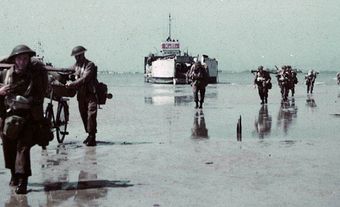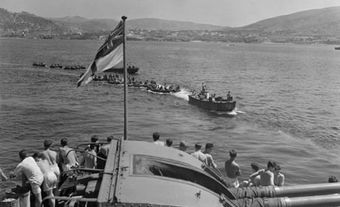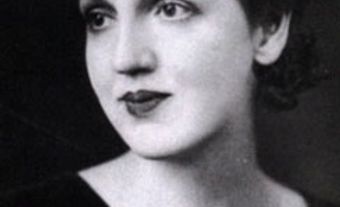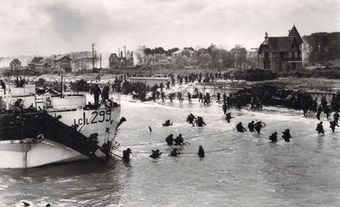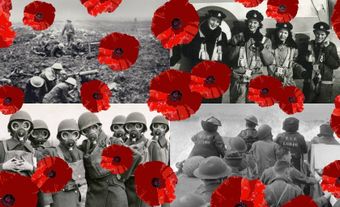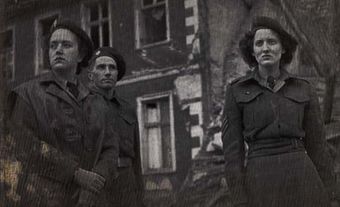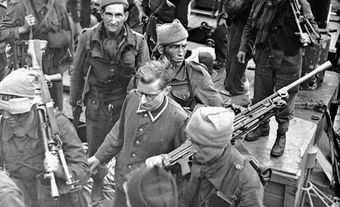Harry Wickwire Foster, CBE, DSO, army officer (born 2 April 1902 in Halifax, Nova Scotia; died 6 August 1964 in Halifax, Nova Scotia). Foster commanded two Canadian divisions in the Second World War and served in the European and Pacific theatres. He was also senior military officer at the trial of SS Waffen General Kurt Meyer (see Normandy Massacres). Foster’s third wife, Mona Parsons, was a member of the Dutch resistance during the war.

Early Life and Education
Harry Wickwire Foster was born in 1902 to Jane Thompson Wickwire and Gilbert Lafayette Foster. His father had been a major-general in the Canadian Army Medical Corps during the First World War. Foster was educated at King’s College in Windsor, Nova Scotia (1915–16); Berkhamsted Grammar School, United Kingdom (1916–19); Bishop’s College in Sherbrooke, Quebec (1919–20); McGill University in Montreal, Quebec, (1920–21) and the Royal Military College (RMC) in Kingston, Ontario (1922–24).
In 1924, Foster withdrew from RMC and received a commission in the Permanent Force, taking up a posting in July with the Lord Strathcona’s Horse (Royal Canadians), an armoured regiment of the Canadian Army. He married his first wife, Margaret “Margo” Ruth Muir, in 1929. In July 1934, Foster was promoted to captain. He attended the British Staff College at Camberley, Surrey, England from 1937 until 1939.
Second World War
In November 1939, Foster was appointed Brigade Major of the 1st Canadian Infantry Brigade. By January 1941 he was promoted to lieutenant-colonel and assumed command of the newly formed 4th Canadian Reconnaissance Battalion (Princess Louise Dragoon Guards), assigned to 1st Canadian Infantry Division in England. Later, in 1942, Foster took up a short assignment as a General Staff Officer 1 (GSO) of the 1st Canadian Division [England] and then was given command of the 1st Battalion, the Highland Light Infantry of Canada.
By February 1943, Foster had been promoted to brigadier-general and appointed commanding officer of the 7th Canadian Infantry Brigade [England]. But within four months, he was recalled from England to command the 13th Canadian Infantry Brigade as part of the 6th Canadian Infantry Division for an amphibious invasion of the Japanese-held Aleutian Island of Kiska, a joint Canadian-American operation known as Operation Cottage.
In September, when Foster had returned to Canada after Operation Cottage, he learned his wife, Margo, had become seriously ill. She died of cancer on 1 December 1943. By mid-January 1944, while his two sons continued with their studies at the Lower Canada College boarding school, Foster was assigned to teach a two-week lecture course on the Kiska operation at the U.S. Infantry Combat Training School in Orlando, Florida. He was then recalled overseas to take command once again of the 7th Canadian Infantry Brigade, part of the 3rd Canadian Infantry Division in the British Second Army, I Corps (the Division would later come under the II Canadian Corps).
D-Day to Victory Europe
On 6 June 1944, Foster led the 7th Canadian Infantry Brigade in the D-Day landings on Juno Beach. On 22 August 1944, Foster was promoted to major-general and assigned command of the 4th Canadian (Armoured) Division. Throughout the fall of 1944, they were part of the liberation forces fighting through France and Belgium.
In late November 1944, Foster was moved to the Italian campaign, taking over command of the 1st Canadian Infantry Division from Major General Christopher Vokes. He and his men celebrated Christmas that year near the banks of the Senio River in northeast Italy; although they were mid-campaign, the divisional officers followed military tradition and served their men Christmas dinner. The next day, Foster remarked, they returned “to the cold reality of war and all its ugliness but we won’t forget Christmas 1944, because for 24 hrs. men became human again and war seemed very far away.”
By March 1945, Foster and his division, and most of the Canadian units serving in Italy, had deployed to northwest Europe as part of Operation Goldflake. In total, over 60,000 troops, support personnel and equipment were moved from Italy to southern France and then to Northwest Europe. Foster later led his men in capturing the city of Apeldoorn and helping liberate the Netherlands.
Upon hearing the news of Germany’s surrender in early May 1945, Foster later recalled, “I think we were all a bit numb. Six and half years is a long time for any many to be thinking about just staying alive and hoping to see that day when it’s all over. Of course we were pleased. We smiled. We joked. But I think everyone was just too bloody tired to get excited.”

Tribunal of Kurt Meyer
In September 1945, Foster received orders to report to Aurich, Germany. He had been appointed senior officer of a Canadian military tribunal, with four other Canadian brigadiers, in the court-martial of SS Waffen General Kurt Meyer of the 12th SS Panzer Division. Meyer was tried for his role in the deaths of 41Canadian prisoners of war (POWs), most of them members of the North Nova Scotia Highlanders and the Sherbrooke Fusiliers. The Canadians had been captured during the Normandy landings on D-Day and shot at or near l’Abbaye d’Ardenne, Meyer’s headquarters. It was one of several massacres that took place in Normandy in 1944. The lead prosecutor for the trial was another Nova Scotia native, Lieutenant-Colonel Bruce Macdonald.
On 28 December 1945, Meyer was found responsible for the killing of 18 POWs and sentenced to death by firing squad; the verdict was read by Foster. The sentence was to be carried out in early January. However, upon a later second review of the judgment, Meyer’s sentence was commuted to life in prison, to be served in New Brunswick’s Dorchester Penitentiary. Meyer served only five years at Dorchester; he was transferred to a German prison in 1951 and released in 1954, with Canada’s blessing. When Foster heard of Meyer’s release, he responded that “it was a political matter and out of my hands.”
Postwar Career and Move to England
Following the Meyer tribunal, Foster returned to Canada in January 1946. He had been assigned command of the Canadian Army’s Eastern Command Headquarters in Halifax, Nova Scotia. In 1950, he took up a two-year appointment in Brussels, Belgium, as chief administrator of the Central European District of the Imperial War Graves Commission (now Commonwealth War Graves Commission). “Being able to do something that made certain those lives would be remembered for all time seemed a heck of a lot more useful than what I was doing in Halifax,” he later told his son.
In September 1952, at the age of 50, Foster retired. He and his second wife, Mollie (whom he’d married in February 1944), moved to England. She had been ill and wanted to return to the land of her birth. When Mollie died in 1958, Foster returned to Canada, eventually settling in Halifax.
Later Life and Marriage to Mona Parsons
In 1959, Foster was appointed honorary aide-de-camp to Canadian Governor General Georges Vanier. That June, Foster married childhood friend Mona Leonhart (née Parsons). She had been a member of the Dutch resistance during the Second World War and was the only Canadian female civilian tried by a Nazi military tribunal in the Netherlands and imprisoned. The couple settled in Chester, Nova Scotia.
Foster died from cancer 6 August 1964 at the age of 62. He was buried with full military funeral honours in the Foster family cemetery plot in Kentville, Nova Scotia. Foster’s military uniforms, medals, battle maps and other historical items were donated by his family to the Army Museum at the Halifax Citadel.
Honours and Medals
- Commander, Order of the British Empire (1945)
- Distinguished Service Order (1944)
- Mentioned-in-Despatches
- Officer, Legion of Merit, U.S.A. (1944)
- Silver Star, U.S.A., (1944)
- Officer, Legion of Honour, France (1945)
- Croix de Guerre avec Palme en Bronze, France (1945)

 Share on Facebook
Share on Facebook Share on X
Share on X Share by Email
Share by Email Share on Google Classroom
Share on Google Classroom





